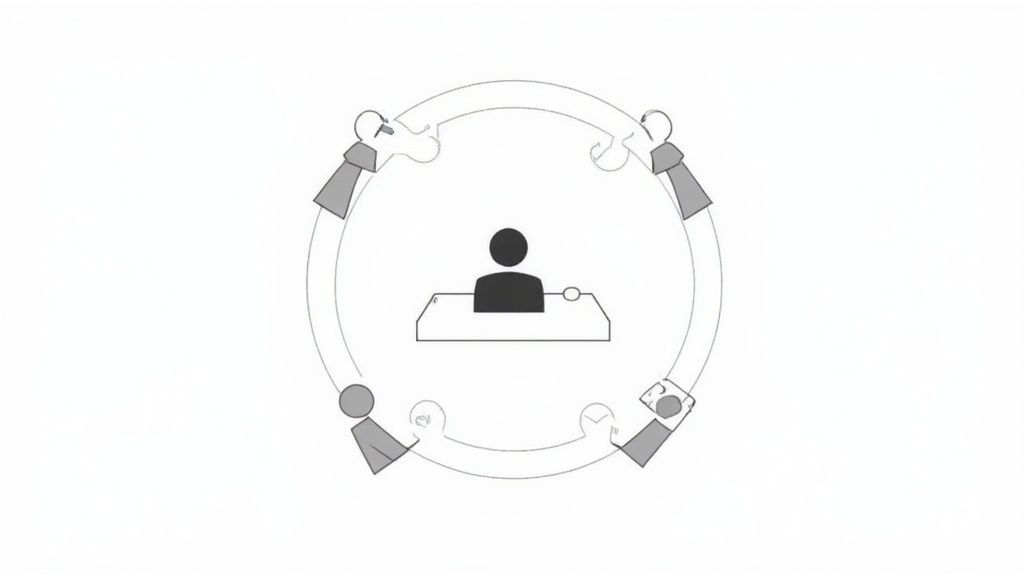Unlocking Potential: Choosing the Right Performance Review Method
Effective performance reviews are crucial for employee development and organizational success. Choosing the right method, however, can be challenging. This listicle provides eight performance review examples, including 360-degree feedback, Management by Objectives (MBO), and Behaviorally Anchored Rating Scales (BARS), to help you find the best fit. We'll explore the pros, cons, and implementation tips for each, empowering you to optimize your performance review process and unlock your team's potential. Explore these performance review examples to identify the approach that best suits your organization's needs.
1. 360-Degree Feedback Review
A 360-degree feedback review is a comprehensive performance evaluation method that gathers input from multiple stakeholders who interact with the employee. This includes not only their manager, but also peers, direct reports, and sometimes even clients or customers. By collecting perspectives from various angles, the 360-degree review provides a more holistic and balanced view of an employee's performance, mitigating potential biases that can arise from a single evaluator's perspective. This approach helps to create a more accurate picture of an individual's strengths, weaknesses, and overall contribution to the organization. Learn more about 360-Degree Feedback Review

This method deserves a prominent place in any discussion of performance review examples due to its comprehensive nature and ability to drive significant individual and organizational growth. It moves beyond the traditional top-down appraisal and encourages a culture of feedback and open communication. The 360-degree review often utilizes standardized questionnaires, incorporating both quantitative ratings and qualitative comments. Anonymity is frequently employed to encourage honest and candid feedback, particularly from peers and subordinates. These reviews are typically conducted annually or semi-annually, providing regular opportunities for reflection and development. Specifically, 360-degree feedback includes features such as feedback from multiple stakeholders, standardized questionnaires, qualitative and quantitative data, potential for anonymity, and regular scheduling.
Pros of 360-Degree Feedback:
- Well-Rounded Perspective: Provides a comprehensive view of performance, capturing strengths and weaknesses that might be missed by a single source.
- Reduced Bias: Minimizes the impact of personal biases from any one individual, leading to a more objective evaluation.
- Blind Spot Identification: Helps individuals identify areas for improvement that they may not be aware of, fostering self-awareness.
- Team Accountability: Encourages team members to provide feedback and support each other's development, fostering a culture of collective responsibility.
- Enhanced Communication: Promotes open communication across hierarchical levels within the organization.
Cons of 360-Degree Feedback:
- Time-Consuming: Can require significant time and resources to administer and analyze the feedback.
- Feedback Overload: The volume of feedback received can be overwhelming for some individuals.
- Potential for Conflict: If not managed carefully, the process can exacerbate existing personality conflicts or create new ones.
- Costly: Administering a comprehensive 360-degree review, especially with external facilitation or software, can be expensive.
- Cultural Challenges: May not be effective in highly hierarchical organizational cultures where open feedback is not encouraged.
Examples of Successful Implementation:
- Google: Utilizes a form of 360-degree feedback in their performance review system, incorporating peer and upward feedback.
- Microsoft: Integrates peer feedback into their review process, empowering employees to provide input on each other's contributions.
- Deloitte: Employs a streamlined approach to 360-degree feedback that focuses on future actions and development planning rather than solely on past performance.
Tips for Effective 360-Degree Feedback:
- Concise Surveys: Keep questionnaires focused and concise, targeting specific behaviors and competencies.
- Ensure Anonymity: Guarantee anonymity where appropriate to encourage honest and candid feedback.
- Training: Provide comprehensive training to all participants on how to provide constructive and actionable feedback.
- Actionable Insights: Focus on providing specific, actionable insights rather than vague impressions.
- Development Plans: Follow up the review process with personalized development plans based on the feedback received.
When and Why to Use This Approach:
360-degree feedback is particularly valuable when aiming to foster leadership development, improve team dynamics, and drive organizational change. It's ideal for situations where a holistic understanding of an individual's performance is crucial, and where fostering a culture of feedback and continuous improvement is a priority. This method is beneficial for HR Professionals and People Leaders seeking to enhance their performance management systems, Business Executives and CEOs looking to drive organizational change, Team Managers and Department Heads aiming to improve team dynamics, Employee Engagement Specialists striving to create a culture of feedback, and organizations focused on culture transformation.
2. Management by Objectives (MBO) Review
The Management by Objectives (MBO) review is a powerful performance review example that focuses on achieving specific, measurable, achievable, relevant, and time-bound (SMART) goals. Unlike traditional performance reviews that often rely on subjective assessments, MBO provides a quantifiable basis for evaluation. At the beginning of the review period, the manager and employee collaboratively set clear objectives. Performance is then measured against these pre-defined targets, making the evaluation process more objective and transparent. This approach fosters a shared understanding of expectations and provides a roadmap for achieving individual and organizational success.

MBO deserves its place on this list due to its focus on results and its ability to align individual efforts with overall business strategy. Key features include collaborative goal setting, the use of SMART objectives, regular check-ins throughout the review period, and an evaluation grounded in concrete results rather than subjective impressions. It’s often directly tied to compensation decisions, providing further incentive for employees to achieve their objectives. You can Learn more about Management by Objectives (MBO) Review for a deeper understanding.
Several leading organizations have successfully implemented MBO. Intel, for instance, incorporates MBO as a core element of their performance management system. Salesforce utilizes a variant called Objectives and Key Results (OKRs), while Hewlett-Packard has historically used MBO for its performance evaluations. These examples demonstrate the adaptability and effectiveness of MBO across different industries.
Pros:
- Clarity on Expectations: MBO eliminates ambiguity by clearly defining what needs to be accomplished.
- Objective Evaluation: Performance is assessed based on measurable results, reducing bias and subjectivity.
- Alignment with Organizational Goals: Individual objectives are directly linked to broader company goals.
- Increased Employee Motivation: Collaborative goal setting and regular feedback empower employees and promote ownership.
- Focused Performance Discussions: Reviews become more productive and focused on tangible outcomes.
Cons:
- Overemphasis on Quantifiable Metrics: MBO can sometimes neglect important qualitative contributions.
- Potential for Reduced Collaboration: Overly individualistic goals can inadvertently discourage teamwork.
- Rigidity in Dynamic Environments: Pre-defined objectives might become outdated in rapidly changing business landscapes.
- Risk of "Sandbagging": Employees might set easily achievable goals to guarantee success.
- Ignoring External Factors: MBO may not account for unforeseen obstacles beyond employee control.
Tips for Effective MBO Implementation:
- Regular Review and Adjustment: Review and adapt objectives quarterly, or as needed, to align with evolving business needs.
- Balanced Goal Setting: Include both ambitious stretch goals and core expectations.
- Qualitative and Quantitative Assessment: Balance quantitative metrics with qualitative assessments of behaviors and skills.
- Alignment with Priorities: Ensure objectives align with both team and organizational priorities.
- Documenting the Process: Document both the what (results) and the how (behaviors) for a comprehensive evaluation.
MBO is particularly useful for organizations focused on driving performance and achieving specific business outcomes. It's an excellent approach for HR professionals, people leaders, executives, team managers, and employee engagement specialists aiming to foster a results-oriented culture and improve overall performance. This method, popularized by management gurus like Peter Drucker, Andy Grove, and John Doerr, provides a structured framework for setting clear expectations, tracking progress, and rewarding achievement. By focusing on measurable results and collaborative goal setting, MBO empowers individuals and teams to contribute directly to organizational success.
3. Behaviorally Anchored Rating Scales (BARS) Review
Behaviorally Anchored Rating Scales (BARS) offer a structured and detailed approach to performance reviews, making them a valuable tool for organizations seeking objective and consistent evaluations. This method distinguishes itself from traditional rating scales by anchoring each level of performance with specific behavioral descriptions. As a performance review example, BARS combines the quantitative aspect of numerical ratings with qualitative behavioral examples, thus painting a clearer picture of employee performance. This makes BARS a powerful tool for providing constructive feedback and fostering employee growth.
Instead of relying on generic descriptors like "good" or "poor," BARS provides concrete examples of what constitutes each performance level. For instance, instead of rating an employee's "communication skills" as a 4, a BARS system might describe a 4 as "Actively listens to colleagues' input during meetings and clearly articulates project updates, adapting communication style to different audiences." This specificity helps reduce ambiguity and ensures that both the evaluator and the employee understand the performance expectations.
How BARS Works:
BARS are customized to specific roles and job functions. A scale (usually 1-5 or 1-7) is used, and for each point on the scale, specific behavioral anchors are defined. These anchors describe observable behaviors rather than abstract traits. For example, for a sales role, a 1 might be "Struggles to meet sales quotas and rarely follows up with leads," while a 5 might be "Consistently exceeds sales quotas and proactively develops new business opportunities."
Features and Benefits:
- Combines quantitative and qualitative data: Providing a more holistic performance picture.
- Customized to specific roles: Ensuring relevance and accuracy.
- Focuses on observable behaviors: Facilitating objective assessment.
- Reduces rating errors: Mitigating common biases like the halo effect and central tendency.
- Provides clear feedback: Enabling actionable development plans.
- Improves consistency across raters: Enhancing fairness and objectivity.
Pros and Cons:
Pros:
- Reduces ambiguity in performance standards.
- Makes feedback more concrete and actionable.
- Improves consistency across different raters.
- Decreases ambiguity in performance standards.
Cons:
- Time-consuming and expensive to develop properly.
- Requires regular updating as job requirements change.
- Can be cumbersome to implement across diverse roles.
- May not fully capture the uniqueness of individual contributions.
- Still contains some subjectivity in determining ratings.
Examples of Successful Implementation:
Several organizations have successfully implemented BARS, including:
- U.S. Federal government agencies for civil service positions.
- Healthcare organizations for nursing performance evaluations.
- Marriott International for customer service positions.
Tips for Implementation:
- Involve job experts when creating behavioral anchors.
- Use clear, specific language that describes observable actions.
- Train evaluators to ensure consistent application.
- Include both positive and negative behavioral examples.
- Regularly review and update anchors as job requirements evolve.
When and Why to Use BARS:
BARS is particularly beneficial when organizations need a structured and objective approach to performance evaluation. It's ideal for roles with clearly defined behaviors and deliverables, where consistency in evaluation is crucial. If your organization is struggling with subjective performance reviews or wants to improve the clarity and actionability of feedback, BARS is worth considering. Learn more about Behaviorally Anchored Rating Scales (BARS) Review.
Why BARS Deserves Its Place in the List:
BARS provides a more robust and objective approach to performance evaluation compared to traditional rating scales. This method’s focus on observable behaviors and its detailed descriptions of performance levels help mitigate bias and improve the quality of feedback. For HR professionals, people leaders, and organizations focused on performance improvement and culture transformation, BARS offers a powerful framework for driving employee growth and development. It's a key performance review example for those looking to go beyond simplistic ratings and delve into the specific behaviors that contribute to success. BARS was popularized by organizational psychologists Patricia Smith and Lorne Kendall in the 1960s, human resources expert Dick Grote, and industrial-organizational psychologist Frank Landy, underscoring its deep roots in the field of performance management.
4. Narrative Performance Review
Narrative performance reviews offer a refreshing departure from traditional, number-driven evaluations. Instead of relying on numerical ratings or simple checkboxes, this approach uses detailed written descriptions to assess an employee's performance. This provides valuable context and nuance often missing from standardized performance review examples. Managers craft comprehensive text-based assessments covering achievements, areas for improvement, and development opportunities, creating a richer, more personalized experience. This method is gaining traction as organizations seek more effective ways to understand and develop their talent.
How It Works:
The narrative review focuses on telling the story of an employee’s performance over a given period. Managers use open-ended questions and prompts to guide their written feedback. This allows them to delve into specific situations, projects, and contributions, illustrating the employee's strengths and weaknesses with concrete examples. Learn more about Narrative Performance Review This approach can also incorporate direct quotes from stakeholders, providing a 360-degree view of performance. Often, narratives are structured around key competencies or job responsibilities, ensuring a focused and relevant evaluation.
Features:
- Open-format written evaluation: Allows for flexible and detailed feedback.
- Focus on specific examples and situations: Provides concrete evidence of performance.
- Context and nuance: Captures the complexities of individual contributions.
- Direct quotes from stakeholders: Offers diverse perspectives.
- Structured around key competencies or job responsibilities: Ensures relevance and focus.
Pros:
- Nuance and context: Captures the intricacies of performance that ratings alone can't.
- Accommodation of unique contributions: Recognizes achievements outside standard criteria.
- Detailed performance record: Creates a valuable historical document for tracking progress.
- Meaningful and personal feedback: Fosters a stronger connection between manager and employee.
- Rich information for development planning: Offers specific areas for growth and improvement.
Cons:
- Time-intensive: Requires managers to dedicate significant time to writing thoughtful reviews.
- Dependent on manager's writing ability: Quality can vary based on the manager's skills.
- Difficult for company-wide comparisons: Lack of standardization makes it challenging to compare performance across teams or departments.
- Potential for subjective bias: Narrative evaluations can be more susceptible to personal biases.
- Challenging to translate into compensation decisions: The absence of quantifiable data can complicate salary and bonus discussions.
Examples of Successful Implementation:
- Netflix: Known for its culture of feedback, Netflix relies heavily on narrative feedback rather than formal ratings.
- Academic Institutions: Many universities use narrative evaluations for faculty, focusing on teaching and research contributions.
- Buffer: This social media management company embraces detailed written feedback as part of its performance philosophy.
When and Why to Use This Approach:
Narrative reviews are particularly beneficial in organizations that prioritize individual development and personalized feedback. They are well-suited for roles where creativity, innovation, and complex problem-solving are highly valued. This approach is also effective when a company is moving away from a traditional, ranking-based system towards a more holistic view of performance. If your organization aims to foster a culture of continuous feedback and growth, narrative reviews are an excellent option.
Tips for Effective Narrative Reviews:
- Provide specific examples: Support general observations with concrete instances of behavior.
- Balance positive and constructive feedback: Highlight both strengths and areas for development.
- Use clear language: Avoid corporate jargon and write in a simple, straightforward style.
- Include quotes or feedback from others: Incorporate diverse perspectives when relevant.
- Structure narratives around key performance dimensions or competencies: Maintain focus and relevance.
This approach to performance review examples, popularized by companies like Adobe and thought leaders like Josh Bersin, as well as pioneering institutions like Antioch University in New Hampshire, emphasizes quality over quantity and recognizes the unique contributions of each individual. By focusing on storytelling and detailed descriptions, narrative performance reviews can create a more impactful and meaningful evaluation experience for both managers and employees.
5. Self-Assessment Review
Self-assessment reviews are a valuable tool in the performance review process, providing a crucial employee perspective often missing in traditional top-down evaluations. This approach, which deserves its place on this list of performance review examples due to its focus on employee engagement and development, requires employees to evaluate their own performance before meeting with their managers. This pre-meeting evaluation serves as a springboard for a more productive and insightful discussion during the formal review. This method is particularly useful for organizations striving to foster a culture of self-reflection, ownership, and continuous improvement.
How Self-Assessment Reviews Work:
The process typically involves employees completing a structured self-evaluation form, often including rating scales supplemented by written explanations. These forms prompt reflection on pre-determined goals, key achievements, areas for improvement, and future development plans. The completed self-assessment then serves as essential input for the manager's evaluation and the subsequent review discussion.
Features and Benefits:
- Structured Self-Evaluation: A standardized form ensures consistency and facilitates comparison across team members.
- Rating Scales and Written Explanations: This combination allows for both quantitative and qualitative feedback, providing a richer understanding of performance.
- Focus on Goals and Development: The self-assessment encourages employees to connect their individual contributions to broader organizational objectives and identify areas for future growth.
- Two-Way Dialogue: The self-assessment acts as a starting point for a collaborative discussion between the employee and manager, fostering a sense of partnership in the review process.
Pros:
- Encourages self-reflection and ownership: Employees actively participate in assessing their performance, promoting accountability and a deeper understanding of their strengths and weaknesses.
- Provides the manager with the employee's perspective: This offers valuable insight into the employee's thought processes, challenges faced, and perceived contributions.
- Highlights perception gaps: Comparing self-assessments with managerial evaluations can reveal discrepancies in how performance is perceived, opening up opportunities for constructive dialogue and alignment.
- Prepares employees for active participation: Employees come prepared to discuss their performance, leading to more engaging and productive review conversations.
- Uncovers overlooked accomplishments: Self-assessments can highlight achievements the manager may not have been fully aware of, ensuring a more comprehensive and fair evaluation.
Cons:
- Potential for self-serving bias: Some employees may overrate or underrate their contributions, influenced by personal biases.
- Quality varies based on self-awareness and writing skills: Self-assessment quality can be inconsistent depending on the individual's capacity for introspection and communication.
- Can create uncomfortable situations: Large discrepancies between self-assessments and managerial evaluations can lead to difficult conversations.
- May feel redundant if not meaningfully incorporated: If the self-assessment is not actively used in the review discussion, it can feel like a pointless exercise.
- Perceived as shifting managerial work: Some employees may view self-assessments as adding to their workload without corresponding benefits.
Examples of Successful Implementation:
Several leading organizations have integrated self-assessments into their performance review processes. Amazon, Accenture, and IBM all utilize self-evaluations to gather employee perspectives and promote self-reflection.
Tips for Effective Implementation:
- Provide clear instructions and examples: Offer guidance on how to complete the self-assessment effectively, showcasing examples of strong self-evaluations.
- Encourage honesty and self-reflection, not self-promotion: Emphasize the importance of providing an accurate and balanced assessment of performance.
- Ask for specific examples: Encourage employees to provide concrete examples to support their self-ratings, making the assessment more objective and insightful.
- Include forward-looking questions: Ask about development goals and future aspirations, aligning individual growth with organizational objectives.
- Actively use the self-assessment during the review conversation: Make the self-assessment the centerpiece of the review discussion, demonstrating its value and fostering a two-way dialogue.
When and Why to Use Self-Assessment Reviews:
This approach is particularly beneficial in organizations aiming to cultivate a culture of feedback, continuous improvement, and employee engagement. It is well-suited for companies transitioning away from traditional top-down performance management to a more collaborative and development-focused approach. The principles of self-assessment are popularized by thought leaders like Peter Senge in his work on learning organizations, Microsoft's implementation under Satya Nadella, and leadership development expert Marshall Goldsmith. By incorporating self-assessment reviews, organizations can transform the performance review process from a dreaded annual event into a valuable opportunity for growth and development.
6. Continuous Performance Review
Continuous performance review is a modern approach to performance management that replaces traditional annual or bi-annual evaluations with ongoing feedback and development throughout the year. This method emphasizes regular communication, real-time feedback, and continuous goal adjustment, fostering a more agile and responsive approach to performance improvement. Instead of relying on potentially outdated observations from months prior, continuous performance reviews create an ongoing dialogue between managers and employees, promoting a culture of feedback and growth. This makes it a compelling performance review example for organizations looking to modernize their processes.

This approach is particularly valuable in today's fast-paced business environment, where annual reviews can feel slow and inadequate for addressing immediate performance needs. Features of continuous performance reviews typically include regular structured check-in meetings (weekly, bi-weekly, or monthly), real-time feedback rather than stored observations, digital tools to document conversations and track progress, agile goal-setting with frequent adjustments, and the separation of development discussions from compensation decisions.
Examples of Successful Implementation:
- Adobe: Adobe pioneered the "Check-in" approach, entirely replacing annual reviews with frequent, informal check-ins between managers and employees.
- Microsoft: Microsoft's performance review approach emphasizes regular conversations about priorities and feedback related to ongoing projects.
- GE: GE transitioned away from its traditional annual review cycle to an app-based continuous feedback system, enabling real-time performance feedback and development.
Pros:
- Timely Feedback: Provides feedback when it's most relevant and actionable, leading to immediate performance improvement.
- Reduced Recency Bias: Minimizes the impact of recency bias, common in annual reviews, where recent events disproportionately influence evaluations.
- Faster Course Correction: Allows for quicker identification and correction of performance issues, promoting continuous skill development.
- Ongoing Dialogue: Creates an ongoing dialogue between managers and employees, fostering a culture of open communication and feedback.
- Adaptability: Better suited to fast-changing business environments where goals and priorities may shift frequently.
Cons:
- Manager Time Commitment: Requires significant manager time and dedication to frequent check-ins and feedback.
- Potential for Overwhelm: Can feel overwhelming for both managers and employees without proper structure and clear expectations.
- Documentation Challenges: May lack formal documentation required for certain legal or regulatory processes.
- Standardization Difficulty: Difficult to standardize across a large organization, potentially leading to inconsistencies in implementation.
- Compensation Complexity: Can complicate compensation decisions without the use of formal performance ratings.
Tips for Implementation:
- Efficient Check-ins: Keep check-in meetings focused and time-efficient (30 minutes or less).
- Documentation: Document key points from conversations for future reference and performance tracking.
- Balanced Feedback: Balance positive reinforcement with constructive feedback to motivate and encourage growth.
- Clear Expectations: Set clear expectations with employees about the frequency, format, and purpose of check-ins.
- Simple Framework: Use a simple framework for each discussion, such as focusing on progress, priorities, and problems.
When and Why to Use This Approach:
Continuous performance reviews are ideal for organizations seeking to foster a culture of continuous feedback, rapid development, and agile performance management. This approach is particularly beneficial for companies in dynamic industries, those with rapidly evolving goals, and organizations prioritizing employee growth and development. This performance review example is especially well-suited for companies looking to move away from traditional, infrequent performance evaluations towards a more modern, engaging, and impactful performance management system. Pioneered by companies like Adobe and championed by HR thought leaders like Ashley Goodall and Marcus Buckingham, continuous performance review is transforming how organizations approach performance management.
7. Competency-Based Performance Review
Competency-based performance reviews offer a structured approach to evaluating employees based on a predefined set of skills, knowledge, and behaviors crucial for success in their roles and within the organization. Unlike traditional reviews that primarily focus on past performance and achieved results, this method emphasizes how the work is accomplished. By assessing employees against consistent standards of excellence related to specific competencies, organizations gain a deeper understanding of individual capabilities and their alignment with overall business objectives. This makes it a valuable addition to our performance review examples.

This approach involves establishing a competency framework that outlines the essential skills and behaviors required for various roles or levels within the organization. These frameworks typically encompass both technical competencies (e.g., software proficiency, data analysis) and behavioral competencies (e.g., communication, teamwork, problem-solving). Each competency is further broken down into proficiency levels with clear descriptive behaviors, providing specific examples of how the competency is demonstrated at each level. Rating scales are then used to assess the employee's proficiency for each competency. For instance, a competency like "Communication" might have levels ranging from "Basic" to "Expert," with detailed descriptions of behaviors expected at each level. This structured approach enables more objective and consistent evaluations across the organization.
Examples of Successful Implementation:
Several leading organizations utilize competency-based performance reviews. McKinsey & Company leverages a competency model for evaluating its consultants, ensuring consistent standards across the globe. Johnson & Johnson employs a leadership competency model to guide its reviews, fostering strong leadership capabilities throughout the company. Numerous government agencies also use competency-based frameworks for civil service positions to maintain standardized evaluation criteria. These real-world performance review examples demonstrate the effectiveness of this approach.
When and Why to Use This Approach:
Competency-based reviews are particularly beneficial when an organization wants to:
- Standardize Evaluations: Create consistent evaluation criteria across different departments and levels.
- Develop Employees: Identify skill gaps and provide targeted development opportunities.
- Promote a Specific Culture: Reinforce desired behaviors and values within the organization.
- Identify High-Potential Employees: Recognize individuals with the necessary competencies for future leadership roles.
- Align Individual and Organizational Goals: Connect individual capabilities with strategic business objectives.
This approach is especially relevant for HR professionals, people leaders, and executives seeking a more structured and development-focused performance management system.
Pros:
- Consistent evaluation standards across the organization.
- Clarified behavioral expectations beyond just results.
- Supports career development by identifying competency gaps.
- Links individual capabilities to organizational success factors.
- Provides a framework for identifying high-potential employees.
Cons:
- May not adequately account for unique role requirements.
- Can feel generic if competencies aren't properly tailored.
- Risk of emphasizing conformity over innovation.
- Complex to develop and maintain competency frameworks.
- May overlook results if too focused on behaviors.
Actionable Tips for Implementation:
- Limit the Number of Competencies: Focus on 8-12 key competencies to avoid overwhelming complexity.
- Balance Competency Types: Include a mix of technical, behavioral, and leadership competencies.
- Provide Clear Descriptors: Offer detailed behavioral descriptors for each proficiency level.
- Customize for Different Roles: Tailor competencies for different functional areas while maintaining core organizational competencies.
- Regularly Update: Review and update competency models as business needs and industry best practices evolve.
By carefully considering these factors and incorporating these best practices, organizations can leverage competency-based performance reviews to drive employee development, improve performance, and achieve strategic goals. This method provides a powerful framework for aligning individual capabilities with organizational needs, making it a valuable tool for any performance management system.
8. Forced Distribution (Rank and Yank) Review
The Forced Distribution (often referred to as "Rank and Yank" or "stack ranking") performance review method is a controversial yet impactful approach that compels managers to evaluate and categorize employees based on a predetermined distribution curve, typically resembling a bell curve. This system mandates that a fixed percentage of employees fall into specific performance categories, often divided into top, middle, and bottom performers. This creates a clear, albeit sometimes harsh, differentiation in performance levels. While it can be a powerful tool for identifying high-potential individuals and driving performance improvement, it's crucial to understand its complexities and potential drawbacks before implementation. This method deserves its place on this list of performance review examples because it represents a significant, albeit controversial, approach to performance management, highlighting both potential benefits and serious risks.
How it Works:
Forced distribution requires managers to slot their team members into pre-defined performance categories according to a fixed distribution. For example, a common distribution might allocate 10% of employees to the top performer category, 70% to the middle, and 20% to the bottom. This means that even in a high-performing team, a certain percentage must be classified as underperforming. This often leads to calibration sessions where managers discuss and defend their rankings amongst their peers, ensuring consistency across the organization. These rankings are then usually directly tied to compensation adjustments, promotions, development opportunities, and sometimes even termination decisions, adding significant weight to the process.
Examples of Implementation:
- General Electric (GE) under Jack Welch: GE's widespread use of the 20-70-10 model under Jack Welch brought forced distribution into the mainstream. While credited with contributing to GE's success during that period, it also fostered intense internal competition. This is a key example demonstrating both potential benefits and significant downsides, which should be carefully considered.
- Microsoft: Microsoft utilized stack ranking for many years, aiming to identify and reward top talent. However, they abandoned the practice in 2013 after facing criticism for fostering a cutthroat environment that hindered collaboration. This example underscores the potential negative impact on company culture and teamwork.
- Yahoo: Yahoo, under Marissa Mayer, implemented a quarterly performance review system with elements of forced distribution, leading to considerable controversy and claims of unfairness. This highlights the risks associated with overly frequent forced rankings and the potential for misuse.
Pros:
- Combats Rating Inflation: Forced distribution directly addresses the common issue of rating inflation where managers tend to rate most employees above average, making it difficult to distinguish true high performers.
- Clear Performance Differentiation: The system creates clear distinctions between performance levels, making it easier to identify top talent and address underperformance.
- Promotes Difficult Conversations: The process forces managers to engage in potentially uncomfortable but necessary conversations about performance issues.
- Identifies High-Potential Employees: It helps identify top performers for accelerated development programs, leadership roles, and rewards.
- Potential for Increased Productivity: By raising performance standards and creating a sense of urgency, forced distribution can drive productivity improvements.
Cons:
- Encourages Internal Competition: The system can foster a hyper-competitive environment that undermines teamwork and collaboration.
- Damages Morale and Increases Stress: The pressure to constantly outperform colleagues can negatively impact employee morale, create anxiety, and contribute to a stressful work environment.
- Demotivating for Average Performers: Average performers, even valuable contributors, may become demotivated knowing they are inherently ranked lower than a percentage of their colleagues.
- Potential for Manager Bias and Gaming: The system can be manipulated by managers who may play favorites or make subjective judgments based on personal biases.
- Legal Risks: If not implemented carefully and fairly, forced distribution can lead to legal challenges, especially if it appears to disproportionately impact certain demographic groups.
- Arbitrary Distinctions in High-Performing Teams: In teams where everyone performs at a high level, the forced distribution can create arbitrary and unfair distinctions.
Tips for Implementation:
- Adapt Percentages: Consider adjusting the distribution percentages based on team size, performance, and organizational context. A rigid, one-size-fits-all approach is rarely effective.
- Safeguards Against Discrimination: Implement robust safeguards, including multiple levels of review and clear performance criteria, to mitigate the risk of discrimination.
- Thorough Manager Training: Provide extensive training for managers on conducting objective evaluations, providing constructive feedback, and handling difficult conversations.
- Multiple Inputs: Use a variety of performance data, including peer reviews, customer feedback, and objective metrics, rather than relying solely on manager opinion.
- Alternatives for Small Teams: Explore alternative performance review methods for small teams where forced distributions may not be statistically valid or appropriate.
This approach, while potentially powerful, should be implemented with extreme caution and a deep understanding of its potential consequences. Consider the specific needs and culture of your organization before adopting this performance review example. It is not a quick fix and requires careful planning, execution, and ongoing monitoring to mitigate its potential downsides.
8-Point Performance Review Comparison Matrix
| Review Method | 🔄 Complexity | ⚡ Resources | 📊 Outcomes | 💡 Ideal Use Cases | ⭐ Key Advantages |
|---|---|---|---|---|---|
| 360-Degree Feedback Review | High coordination; multi-source process | Moderately high – requires surveys & aggregation | Comprehensive, unbiased performance view | Collaborative organizations with diverse perspectives | Reduced single-source bias; well-rounded insights |
| Management by Objectives (MBO) Review | Moderate – needs aligned, SMART goal-setting | Moderate – structured check-ins & review meetings | Clear, measurable objectives and results | Goal-driven environments with performance-linked decisions | Objective evaluations; clear expectations |
| Behaviorally Anchored Rating Scales (BARS) Review | High – detailed, behavior-specific calibration | High – expert input & regular framework updates | Consistent ratings with concrete behavioral examples | Roles where precise behavioral benchmarks are essential | Reduces rating errors; improves consistency |
| Narrative Performance Review | High – extensive, text-based evaluation | High – reliant on manager’s writing and detail | Rich qualitative insights with context | Development-focused reviews and personalized assessments | Nuanced, detailed feedback capturing unique contributions |
| Self-Assessment Review | Low – employee-led evaluation | Low – simple self-reflection forms | Reveals self-perception and performance gaps | Cultures that value self-reflection and discussion | Encourages ownership; opens dialogue for review |
| Continuous Performance Review | High – frequent check-ins and ongoing documentation | High – needs digital tools and regular manager engagement | Timely feedback for agile course correction | Fast-paced, agile environments requiring real-time insights | Real-time alignment; continuous improvement |
| Competency-Based Performance Review | Moderate to high – developing tailored frameworks | Moderate – periodic updates to competency models | Standardized evaluation across key competencies | Organizations focusing on career development and skill alignment | Clarifies expectations; links skills with success |
| Forced Distribution (Rank and Yank) Review | Moderate – enforced ranking and calibration sessions | Moderate – requires structured calibration processes | Distinct performance categorization | Highly competitive cultures where clear differentiation is critical | Prevents rating inflation; identifies top talent |
Empowering Growth: Leveraging Performance Reviews for Success
This article explored a range of performance review examples, from 360-degree feedback and Management by Objectives (MBO) to Behaviorally Anchored Rating Scales (BARS) and continuous performance reviews. We also examined narrative reviews, self-assessments, competency-based reviews, and even the controversial forced distribution method. Each approach offers unique advantages and considerations, highlighting the importance of selecting the right fit for your organizational culture and goals. The key takeaway is that mastering these diverse performance review examples allows you to tailor your approach, maximizing employee development and driving overall performance. By understanding the nuances of each method, you can transform performance reviews into a powerful engine for growth, fostering a culture of continuous feedback and improvement, rather than a dreaded annual event. This shift in perspective benefits not only individual employees but also strengthens teams, departments, and the entire organization. Embrace the opportunity to cultivate a thriving and high-performing workforce through strategic performance management.
Ready to streamline your performance review process and unlock the full potential of your team? Happily.ai offers a comprehensive platform to manage various performance review examples, providing data-driven insights to enhance your strategy. Visit Happily.ai today to learn more and revolutionize your performance management.









